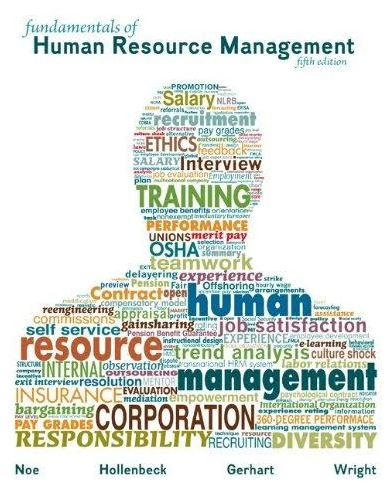
Fundamentals of Human Resource Management 5th Edition by Raymond Noe, John Hollenbeck, Barry Gerhart, Patrick Wright
Edition 5ISBN: 9780077515522
Fundamentals of Human Resource Management 5th Edition by Raymond Noe, John Hollenbeck, Barry Gerhart, Patrick Wright
Edition 5ISBN: 9780077515522 Exercise 5
IS IT FAIR TO FAVOR UNIONIZED FACILITIES?
As General Motors has rebounded from its near-bankruptcy following the financial crisis and recession of a few years ago, it has been adding shifts, reopening factories, and calling back workers. All of those moves are potentially good news for the United Auto Workers union, which represents many-but not all-GM factory workers. So the union is trying to make sure that its members benefit from the company's renewed prosperity.
At GM's factory in Lordstown, Ohio, employees are working around the clock to assemble the Chevrolet Cruze. At the assembly plant in Moraine, Ohio, however, the doors have remained closed. The workers in Moraine were not UAW members, and when the union negotiated with GM, it demanded that its members be given priority for rehiring. Non-UAW workers are not allowed to transfer to unionized plants. A UAW negotiator explained to a reporter that it was unfortunate some workers would be shut out of the recovery, but "we had to take care of our own members." If the company needs more workers than the union can provide, GM can hire workers from Moraine, but they will be considered new employees, and their wage rate will be lower. On the current pay scale, a newly hired UAW worker earns on average $14 per hour; experienced workers earn about twice as much. Under the current contract, workers can earn a series of raises over time, eventually reaching $19 per hour.
These decisions are part of a complicated history in response to years of global expansion and stiff competition. GM almost closed the unionized Lordstown plant in 2007 and moved the assembly of small cars to Mexico. But UAW and GM negotiated an agreement aimed at making the Lordstown plant more competitive. One important area of concessions in 2007 was that GM began allowing a two-tier pay scale in which newly hired workers earn much less than workers on the prior pay scale. Then when the U.S. government provided a financial rescue to GM in 2009, it negotiated concessions from the UAW, including no cost-of-living pay increases and a contract clause forbidding strikes. The UAW hoped members would accept those concessions in exchange for their priority place in line when GM began to grow again. The union emphasizes that its priority is job creation for its members.
In its negotiations with GM management, whose well-being has the UAW sought to protect? Whose well-being should the UAW be protecting? Why?
As General Motors has rebounded from its near-bankruptcy following the financial crisis and recession of a few years ago, it has been adding shifts, reopening factories, and calling back workers. All of those moves are potentially good news for the United Auto Workers union, which represents many-but not all-GM factory workers. So the union is trying to make sure that its members benefit from the company's renewed prosperity.
At GM's factory in Lordstown, Ohio, employees are working around the clock to assemble the Chevrolet Cruze. At the assembly plant in Moraine, Ohio, however, the doors have remained closed. The workers in Moraine were not UAW members, and when the union negotiated with GM, it demanded that its members be given priority for rehiring. Non-UAW workers are not allowed to transfer to unionized plants. A UAW negotiator explained to a reporter that it was unfortunate some workers would be shut out of the recovery, but "we had to take care of our own members." If the company needs more workers than the union can provide, GM can hire workers from Moraine, but they will be considered new employees, and their wage rate will be lower. On the current pay scale, a newly hired UAW worker earns on average $14 per hour; experienced workers earn about twice as much. Under the current contract, workers can earn a series of raises over time, eventually reaching $19 per hour.
These decisions are part of a complicated history in response to years of global expansion and stiff competition. GM almost closed the unionized Lordstown plant in 2007 and moved the assembly of small cars to Mexico. But UAW and GM negotiated an agreement aimed at making the Lordstown plant more competitive. One important area of concessions in 2007 was that GM began allowing a two-tier pay scale in which newly hired workers earn much less than workers on the prior pay scale. Then when the U.S. government provided a financial rescue to GM in 2009, it negotiated concessions from the UAW, including no cost-of-living pay increases and a contract clause forbidding strikes. The UAW hoped members would accept those concessions in exchange for their priority place in line when GM began to grow again. The union emphasizes that its priority is job creation for its members.
In its negotiations with GM management, whose well-being has the UAW sought to protect? Whose well-being should the UAW be protecting? Why?
Explanation
A union is formed to represent group of ...
Fundamentals of Human Resource Management 5th Edition by Raymond Noe, John Hollenbeck, Barry Gerhart, Patrick Wright
Why don’t you like this exercise?
Other Minimum 8 character and maximum 255 character
Character 255


